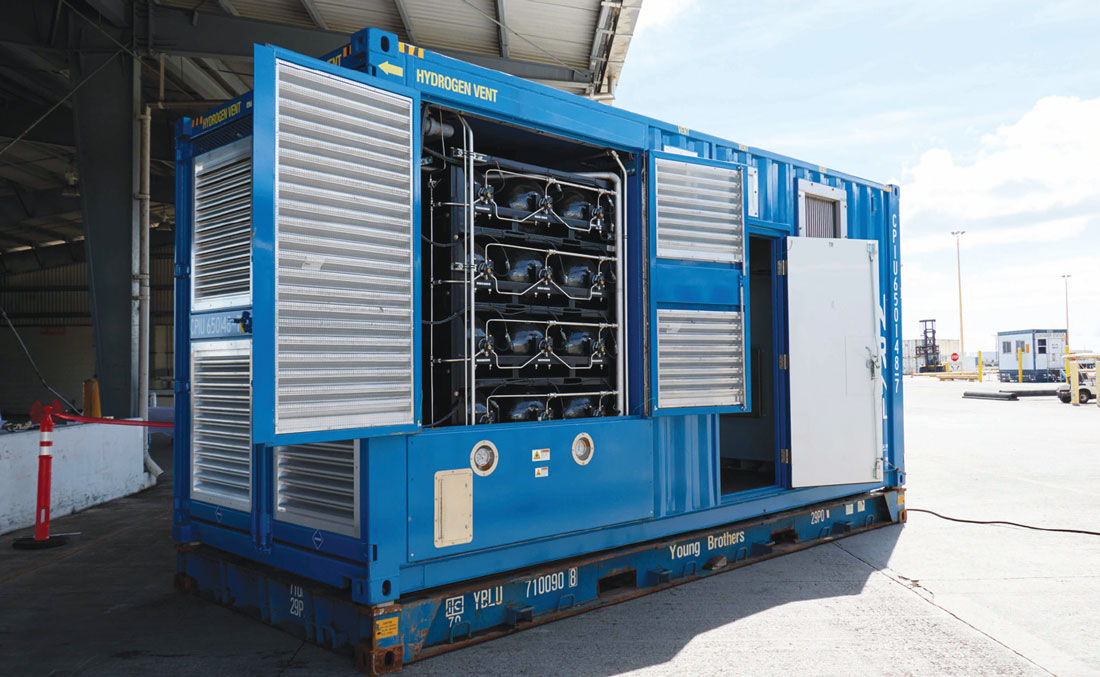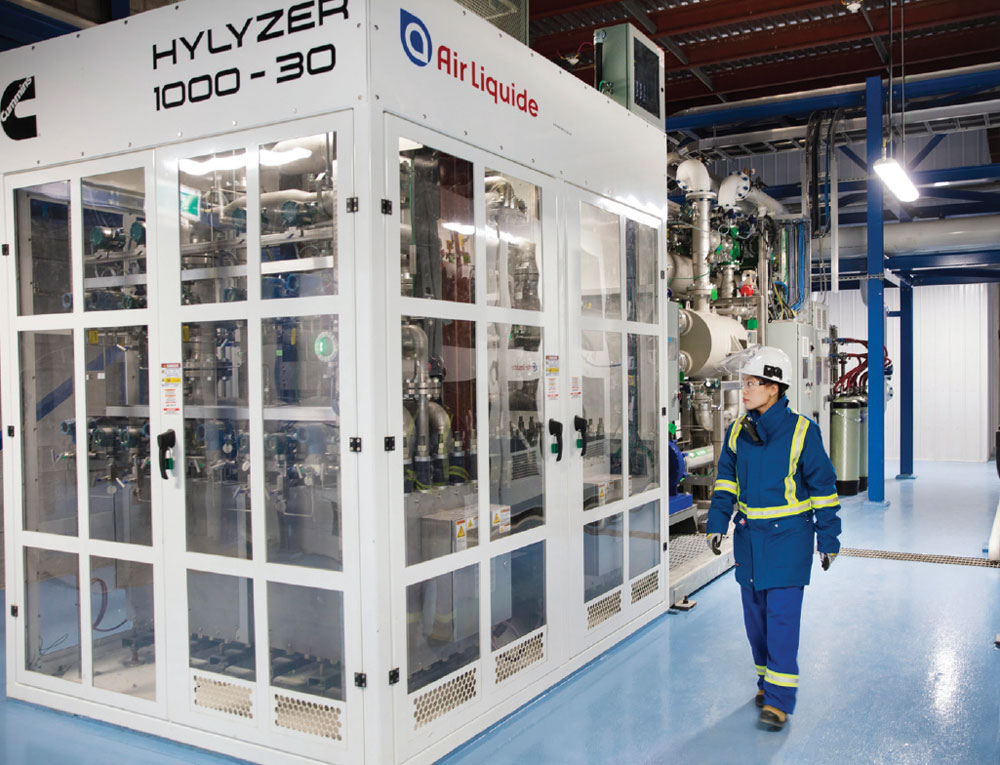
Most of us are exposed to a variety of fuels and energy sources each day. The more common include gasoline, natural gas, propane, and electricity. All of these can be hazardous and can create significant risks if not handled properly. We have grown comfortable, if not complacent, with most of these even though they can cause harm or damage property. Introducing a new fuel to the mix, hydrogen, should not cause us to shrink back, especially if it can bring significant benefits.
By Nick Barilo, Executive Director, Center for Hydrogen Safety
Global interest in using hydrogen is growing quickly as it is expected to play a critical role in the global energy transition. Innovations in hydrogen technologies are developing rapidly to address this growing interest in hydrogen as a fuel. As with any new technology, safety issues can be a ‘deal breaker’ and must be addressed for successful hydrogen technology acceptance and deployment. Safe design and use of hydrogen will play a vital role in minimizing incidents and enabling broad adoption of hydrogen as a transformative fuel. The use of hydrogen in industry has a stable foundation. It can be used safely and has been for nearly a century. Safety knowledge and best practices are shared in industry publications, at conferences, and globally via industry groups like the Center for Hydrogen Safety (CHS). However, hydrogen’s application as a fuel is a an emerging concept to both the public and many energy organizations. Lack of experience with hydrogen as a fuel source can result in flawed assumptions such as:
• ‘Hydrogen is too dangerous’ – a fear voiced by many who do not understand its proper-ties or safe practices.
• ‘Hydrogen is like any other flammable gas’ –a misconception by some new users.
• ‘We already know how to use hydrogen safely’ – an apathy around those established users.
Failure to address the knowledge gaps can result in dangerous and unnecessary incidents, pervasive misconceptions, and industry setbacks.
Hydrogen properties
Hydrogen was identified as a distinct element in 1766. It is a colorless, odorless, tasteless gas that is undetectable by the human senses. Hydrogen is non-toxic and non-poisonous but can be an asphyxiant at high concentrations in enclosed spaces and cause embrittlement in some metals. It is a very small molecule that can diffuse through many materials considered airtight or impermeable to other gases. At standard temperature and pressure, hydrogen is a gas 14 times lighter than air and rises at 20 m/s, thus dispersing rapidly after any stored pressure effects have dissipated. Hydrogen is also flammable, having a wide flammability range (4–75% by volume in air), is easily ignited and has a high burning velocity.
Liquid hydrogen is cryogenic. Hydrogen cannot be compressed to a liquid state but must be chilled to -253°C. Liquid hydrogen is 14 times lighter than water, has a light blue tint, and is non-corrosive. When liquid hydrogen is exposed to higher temperatures, it rapidly vaporizes and creates a fog-like plume, even in drier climates. Hydrogen has a liquid-to-gas volume ratio of 1:848 at standard temperatures and pressures.

Applied safety as an essential element

The best methods for handling, storage, transport, and use of this emerging fuel source may not be well understood by new adopters. A one-size-fits-all approach is not just ill-advised when working with hydrogen – it’s dangerous. Research activities play an important role in understanding the hazards of a fuel and the risks for intended applications. That said, applied safety concepts and practices are critical for deploying the technology to establish a safer, more effective workforce.
When considering applied hydrogen safety, we are referring to those practical features and considerations to help ensure safety when using this new and transformative fuel. These go beyond theoretical considerations. Applied hydrogen safety is based on three pillars:
• Implementing regulations, codes, and standards
• Utilizing best safety practices
• Being invested in safety
While there are three separate pillars, they work best when implemented together. For example, being aware of codes and standards necessary for handling hydrogen is a positive approach. However, this knowledge is useless if a company fails to train employees or invest in the necessary resources to ensure these codes and standards are adhered to.
Codes and standards
Regulations, codes, and standards (RCS) are maturing quickly for many mainstream hydrogen and fuel cell applications. The purpose of regulations, codes, and standards is to:
• Provide the information needed to safely build, maintain, and operate equipment, systems, and facilities.
• Ensure uniformity of safety requirements.
• Provide inspectors and safety officials with the information needed to approve systems and installations.
• Bolster public and stakeholder confidence and help protect investments.
Codes and standards typically identify
the minimum requirements necessary to limit risk to acceptable levels. Those levels are determined by stakeholders and code development organizations. When consider-ing safety codes and standards, the primary focus is typically public and worker safety, preventing adverse impacts to neighbors, and limiting impacts to first responders who may be responding to an incident. Many codes and standards are based on indus try lessons learned and established best practices. An extensive database of global hydrogen codes and standards can be found at H2 Tools, an online portal that brings together and enhances the utility of various tools and web-based content on the safety aspects of hydrogen and fuel cell technologies. While necessary, relying on codes and standards exclusively from the other two pillars is an incomplete approach to safety.

Best safety practices
Hydrogen best safety practices are based on a wealth of knowledge and experience related to the safe use and handling of hydrogen and exist as a result of an extensive history in a wide variety of industrial and aerospace settings. For example, the CHS and its member organizations engage in regular knowledge sharing from real-world incidents to ensure best practices are utilized and mistakes are not repeated. Utilizing best safety practices:
• Implements the benefits of extensive experience in the safe use of hydrogen.
• Protects people, equipment, and the environment – and minimizes the risk of incidents.
• Is demonstrated by their incorporation into designs, standard operating procedures, and organizational values.
Best practices ensure that past experiences will help the industry avoid future incidents and setbacks. These go beyond codes and standards because best safety practices extend beyond codes and standards and are essential for protecting an organization’s assets, reputation, long-term mission, and success, which are not often well addressed by RCS. These practices help establish a comprehensive safety approach suited for an organization’s specific needs. CHS regularly provides updated best practices to member organizations and other safety professionals via the H2 Tools portal.
Being invested in safety

Without a commitment to safety, the other pillars will not be enough to guard an organization long-term. An organization’s beliefs, perceptions, and values directly impact safety culture. Too often organizations view safety as a box to be checked rather than a mentality that must be pervasive throughout the company and everything it does. Investment in safety is critical for building a sustainable legacy, maximizing an organization’s impact and ensuring long-term acceptance of the hydrogen industry.
Investment in safety takes shape in many forms:
• Espousing safety as a core value
• Establishing and enforcing high standards of performance
• Empowering individuals to successfully fulfill their safety responsibilities
• Ensuring open and effective communications
• Establishing a questioning and learning environment
• Fostering mutual trust
• Providing a timely response to safety issues and concerns
• Providing continuous monitoring of performance
• Committing employees’ time to training
These efforts promote a culture of safety, which should be reinforced at every level of an organization. Executives and those in supervisory roles can lead by following safety policies themselves and promoting safety as a core organizational value. Safety efforts must be viewed as complementary to productivity and profitability goals rather than in conflict with them. Positive safety culture is the glue that holds the pillars together and ensures their success and positive impacts.
Conclusion

Commitment to hydrogen safety has worthwhile bene fits, namely in the safety and health of people who work and live in environments where hydrogen is used. However, there are broader goals when advancing hydrogen safety because it has serious implications for global sustainability. Adherence to safety measures and a continued commitment to sharing best practices will play a key role in how, when, and where hydrogen is deployed. Hydrogen has proven to show promise in cleaner fuel use, but it will never be adopted on a global scale unless it can be utilized safely. The CHS has additional resources on the safe use of hydrogen, and an international community where knowledge sharing takes place.
We look forward to sharing additional information with Hydrogen Tech World in the coming months, or you can visit our website today at aiche.org/chs.
About the CHS
 The Center for Hydrogen Safety (CHS) is a nonprofit, impartial and politically neutral corporate membership organization that promotes the safe operation, handling, and use of hydrogen and hydrogen systems across all installations and applications. Within the CHS is the Hydrogen Safety Panel, which was created to address concerns about hydrogen as a safe and sustainable energy carrier.
The Center for Hydrogen Safety (CHS) is a nonprofit, impartial and politically neutral corporate membership organization that promotes the safe operation, handling, and use of hydrogen and hydrogen systems across all installations and applications. Within the CHS is the Hydrogen Safety Panel, which was created to address concerns about hydrogen as a safe and sustainable energy carrier.
A global technical community within the American Institute of Chemical Engineers (AIChE), the CHS builds upon the technical expertise embodied by AIChE, its Center for Chemical Process Safety (CCPS), and partnering organizations to identify and address concerns regarding the safe use of hydrogen as a sustainable energy carrier, in commercial and industrial applications, and hydrogen and fuel cell technologies.


